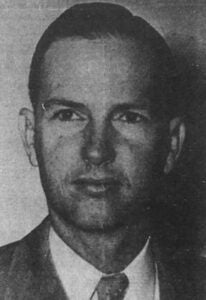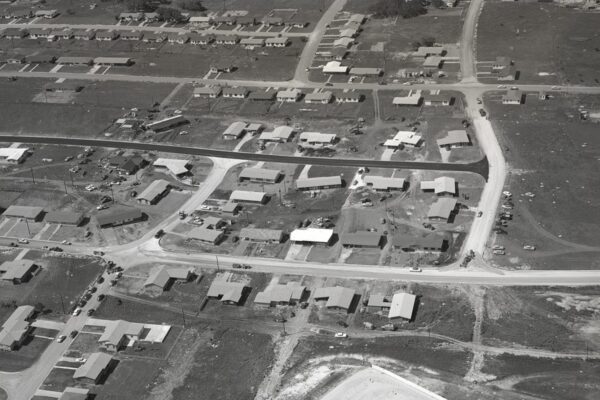LISTEN – 8:53
If you are in a home with central air conditioning at the moment (as many hopefully are), raise a glass to Ned Cole and his alma mater, The University of Texas at Austin.
In the mid-1950s, homes with occupants fortunate enough to have air conditioning were cooled by window units. Central air conditioning did exist but only in large buildings like department stores or else in large, expensive homes.
In 1952, a 34-year-old go-getter named Ned Cole, a 1939 UT architecture graduate, homebuilder, and chairman of the National Association of Home Builders’ air conditioning committee, decided it was time to make central air conditioning a reality for the middle class.

One big motivation was that the Federal Housing Administration and the Veterans Administration were reducing loan amounts on air-conditioned houses on the assumption that borrowers would have to spend so much on electricity that they wouldn’t be able to make the mortgage payments. Cole wanted to disprove this assumption, and that task would require data. Over the next two years he got buy-in from various trade groups for a research project that would come to be known as the Austin Air-Conditioned Village.
Austin was picked for two stated reasons: “because of the conditions of both humid and arid zones,” and “research facilities available at the University of Texas,” according to the Austin American-Statesman. A third reason, undoubtedly, was that it was Cole’s home turf.
Some 22 homes, many designed by Cole himself, would be built on the outskirts of northwest Austin in an area known as Allandale. (Today, of course, the neighborhood between Burnet and MoPac north of 45th Street is practically central Austin.) “To eliminate variations, a flat treeless area was selected,” wrote George Maxwell, a master’s student in architectural engineering at the time who built one of the homes, bought it, and then wrote his master’s thesis on the village.
We used to get mad at each other every June and stay that way all summer."
The test homes were roughly 1,400 square feet and sold for about $12,000, but that’s where the similarities ended. They were intentionally diverse to learn as much as possible about central air conditioning and middle-class homes. They were on both slab and pier-and-beam foundations. They were oriented every which way on their lots to test the angular effects of the sun, with windows large and small with various exposure to the sun. They were built in a variety of styles with a variety of materials and types of insulation. Some had vents in the floors, others in the ceiling, and others in walls. And each was fitted with a different brand of AC unit.
By June 1954 it was ready, and hundreds of homebuilders, officials and national reporters descended on Allandale for the grand opening of the Austin Air-Conditioned Village. The organizers leaned hard into Texas stereotypes and the national obsession with cowboy culture, with a chuckwagon lunch for the masses, a state trooper opening the ceremony by blowing a block of ice apart with his pistol, and the Travis County Sheriff’s Posse wildly galloping its horses around the suburban homes. After the house tours, they retired to The Driskill hotel for a technical session with 10 speakers.
Then, 20 families, the proud new homeowners and guinea pigs, moved in, and a summerlong study commenced. (All but two houses sold in time for the study.) While industry researchers seem to have done most of the study on the technical and economic aspects of village homes, researchers from UT’s Health Service and Psychology Department took the lead in studying the effects on the artificially cooled humans.
The Fort Worth Star-Telegram reported: “Being guinea pigs doesn’t bother the villagers in the least; on the contrary, they’re delighted at beating the potential Texas heat. Says one woman: ’We are a much happier family now. We used to get mad at each other every June and stay that way all summer. Now, I don’t even mind having to water the lawn or pull weeds. I can always run back to the cool house.’”
Professor W.W. Dornberger, chairman of UT’s Department of Architectural Engineering, organized meetings with the homebuilders association to coordinate UT’s part of the study, which included a joint thesis project among multiple master’s students.
Clifton H. Pieper, a master’s student in architectural engineering, conducted extensive surveys with the families that covered the waterfront. He asked about the number of hours the houses were occupied, thermostat settings, humidity control, removal of bathroom odors, kitchen habits, general family health and children’s playtime indoors vs. outdoors, noise, cleaning, and insect control. (“All 20 families reported being troubled with scorpions,” he wrote, the leading theory being that scorpions sought cool, shady places.)
Other changes reported were that mothers baked more, families ate heavier foods, and they were more apt to choose hot drinks. Also, with windows closed more, homeowners were more likely to decorate with white furniture and rugs, as those items had shown dirt with open windows.
The long-term results for homeowners were mixed, as would be expected in an experiment. In his thesis, Maxwell wrote: “Orientation of the houses was bad and resulted in higher heat gain than anticipated even when shading devices were deployed. The bad examples in the Village were valuable in the respect that they showed how much poor planning affects the efficiency of air conditioning.”
Interest extended even overseas, and in 1955, in the depths of the Cold War, a 10-member delegation from the Soviet Union, after much diplomatic effort, sojourned to Allandale.
To some occupants of the village (hay fever and asthma sufferers), air conditioning was found to be a necessity..."
Today, about two-thirds of the houses still stand, and the village’s addition to the National Register of Historic Places was backed by the Texas Historical Commission.
As graduate student Maxwell wrote, “One definite conclusion to be drawn from the results of the Air-Conditioned Village experiment is that air conditioning is economically feasible for middle-income groups, and with proper design may be feasible for lower income groups.”
He continued: “To some occupants of the village (hay fever and asthma sufferers), air conditioning was found to be a necessity — for they stated that only through the filtered dry air did they experience relief from those ailments. To others, it afforded restful sleep from the stifling summer nights that had rendered them fatigued and useless during previous summers. To still others, it meant a change in living habits — children played indoors more of the time and complained less about naps. There was more indoor living and less use of patio and porch.”
Perhaps the Austin Air-Conditioned Village experiment is summed up best by one sentence from Maxwell’s thesis: “No one encountered in this test considered air conditioning not worth the cost.”




